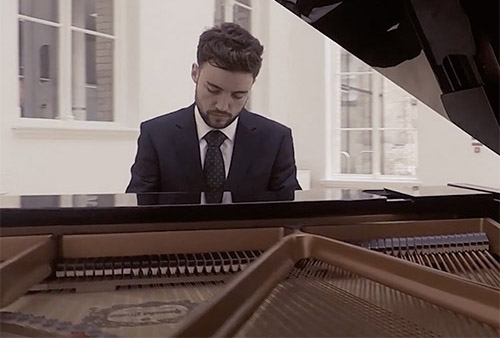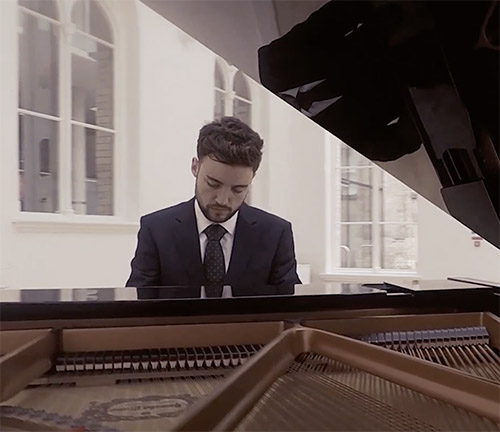Syllabus Overview
Our Essential Jazz Harmony Syllabus is designed for new PianoGroove students who are ready to take on more information and move at a faster pace to learn the essential components of jazz harmony.
What Will You Learn In These Courses?
- Foundational jazz theory (scales, chords, progressions)
- How to play chord extensions (9s, 11s, 13s)
- Rootless voicings and stride left hand style
- How to play chord alterations (b9s, #9s, #11s, and b13s)
Starting with the absolute basics, we work through the most important theory milestones for beginner/early intermediate jazz students.
Learning Path
Our Essential Jazz Harmony learning path can be broken down into 7 key areas of jazz theory. We cover the theory, practice drills and exercises, and apply to jazz standards.
Jazz Piano Foundations
Scales are the foundation of harmony and the first step to understanding jazz. This course covers all the 12 major scales and how they are related to the circle of fifths. We cover the 3 types of minor scales: natural, harmonic & melodic.
Chord Extensions: 9ths, 11ths, & 13ths
If we extend our chords past the 7th degree of the scale, we access 9ths, 11ths, and 13ths. We introduce 3 useful extended voicings and cover exercises to memorise these voicings in all 12 keys.
Extended 251 Progressions
Now that we understand the concept of chord extensions, we can add these tones to our 251 progressions to create more sophisticated sounds. We explore 251 drills to help us visualise the 9th and 13th extensions in major 251s.
Rootless Voicings & Stride Style
We then explore rootless harmony which sets the foundation to study more advanced voicing techniques. When playing chords in jazz, we can omit the root and also rearrange the notes to achieve different sounds and textures.
Minor 251 Progressions
After studying the major 251 we can then move onto the minor 251 progression. Minor harmony is more complex than major harmony and sets the foundation for our upcoming study of chord alterations and altered harmony.
Chord Alterations: b9s, #9s, #11s, and #5s
By altering the upper extensions of our dominant chords, we can create more interesting and colourful chord progressions and arrangements. The altered chord tones are used to add colour, texture, and tension to our voicings to create that authentic jazz sound.
Upper Structure Triad Voicings
Upper Structure Triads are triads that are superimposed above a dominant chord to achieve specific altered chord voicings. By visualising the upper and lower structure of our chords, it allow us to memorise the formulas for complex altered dominant sounds.
Courses
The Essential Jazz Harmony contains 5 courses which should be studied in the following order:
1. Jazz Piano Foundations Course
2. Extended Chords & Voicings
3. Rootless Voicings & Stride Piano
4. Altered Harmony & USTs
5. Whole Step 251 Exercises
Your Teachers

Hayden Hill
Hayden founded PianoGroove in 2015 with the goal of making the world a more musical place. He shares his love for jazz piano through his online courses and manages the community area of PianoGroove.
View Full BioRelated Seminars
Forum Threads
Ask questions to get prompt replies from our team of teachers, participate in improvisation exercises and studies, and join in the discussion with students and teachers from around the globe:
 Essential Jazz Harmony: Roadmap & Syllabus
Essential Jazz Harmony: Roadmap & Syllabus Chord Extensions Practice Planner
Chord Extensions Practice Planner Rootless Voicings Practice Planner
Rootless Voicings Practice Planner Question About 9th Chords
Question About 9th Chords Kenny Barron Minor 11th Voicings
Kenny Barron Minor 11th Voicings Understanding Rootless Voicings
Understanding Rootless Voicings How To Practice Major 251s
How To Practice Major 251s How To Practice Minor 251s
How To Practice Minor 251s Tunes For Practicing Minor 251s
Tunes For Practicing Minor 251s Naming Chord Extensions In Jazz
Naming Chord Extensions In Jazz The -11b5 Voicing in Minor 251s
The -11b5 Voicing in Minor 251s Altered Harmony Practice Planner
Altered Harmony Practice Planner How To Learn Upper Structure Triads
How To Learn Upper Structure Triads How To Add Alterations To Chords In Jazz
How To Add Alterations To Chords In Jazz Suspended Chords Theory
Suspended Chords Theory
Student Reviews
It’s what our students say that really means something. We use Trustpilot because it tells us – and everyone else – exactly what real students think of our online school and community. These reviews tell us what our students love. What they love a little less. And where there’s room for us to improve. Read on to find out what PianoGroove’s students think of our service:









